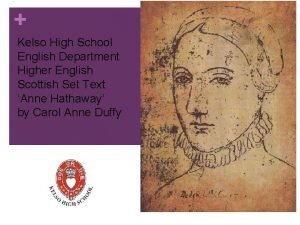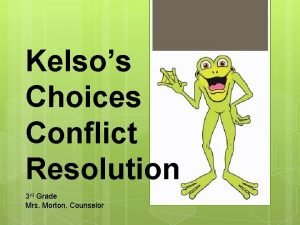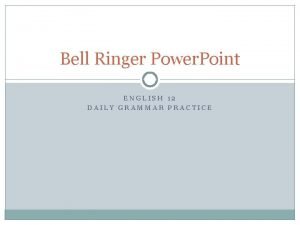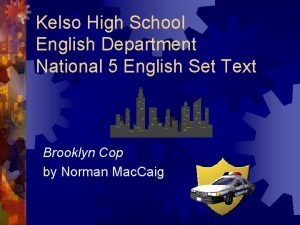Kelso High School English Department To Kill a
















- Slides: 16

Kelso High School English Department

‘To Kill a Mockingbird’

Chapters Twelve, Thirteen, Fourteen & Fifteen – Plot Summary • • • Structure Plot Summary / Key Incidents Narrative Technique Characterisation – Jem Characterisation – Atticus Theme - Prejudice and Intolerance Theme – Courage Theme – Growing Up Theme - Innocence

Structure • Novel divided into TWO parts. • Part One shows the three children – Jem, Scout and Dill learning lessons about life and people. • Childish innocence of Part One is described over a long period of school years. • Part Two deals with the lead up to the trial, the trial itself and the aftermath. • Part Two deals with a far shorter and specific time – maybe suggesting that the trial was the most important event of their childhood.

Plot Summary / Key Incidents • Chapters 12 -15 Summer 1935 • Calpurnia takes Jem & Scout to her church • Aunt Alexandra arrives • Dill returns to Maycomb • A lynch mob tries to take Tom from the jail • Scout talks to Mr Cunningham

Narrative • The use of the child’s perspective as the narrator in Chapter 15 increases the tension in the story as we (the readers) understand the danger that Atticus is in, but Scout does not.

Characterisation – Jem • At the end of Part One Jem is still a young boy who “buried his face in Atticus’s shirt’ • In Part Two Jem is growing up and Scout finds it hard to accept the changes in him. • He makes clear to Scout that he does not want their relationship to continue as before Homework Task: Quotation (Chapter 12) • He is beginning to understand things from an adult’s point of view Homework Task : Quotation (Chapter 14)

Characterisation - Atticus • Atticus sometimes acts as a bridge between the black and white communities – he is chosen to defend Tom Robinson and both he and Scout manage to control the mob outside the jail and prevent them from harming Tom Robinson. A man who was less respected and valued would have been unable to do this, especially without violence.

Theme: Prejudice and Intolerance • In Chapter 12 Jem and Scout are made to feel unwelcome by Lulu in the coloured church because they are white Homework Task: Quotation (Chapter 12) • By showing the rest of the congregation as welcoming, Lee emphasises the goodness of the black community and this makes the racism of the white community even more emphasised. • Calpurnia has had to teach her children to read and write because education is SEGREGATED and there is no school for black people in Maycomb. The fact that she cannot speak “White” in church illustrates another division between blacks and whites.

Theme: Prejudice and Intolerance • Because of their racial prejudice, the townspeople are prepared to accept the word of cruel, ignorant Bob Ewell over that of a decent black man. • As soon as word gets out that Atticus will defend Tom the comments start: “ We would… sometimes hear ‘There’s his chillun’ or ‘Yonder’s some Finches’” • The fact that Tom Robinson is black means he is not thought worthy of a fair trial by many of the Maycomb inhabitants. This is why the lynching party descends on the jail.

Theme – Courage • Atticus waiting at the jail for the lynch mob in order to protect Tom from the threat of mob violence is a sign of his courage. Task – Explain why. • Jem refusing to leave Atticus to go home is another example of courage.

Theme – Growing Up • The children learn that Calpurnia leads a double life so she is able to fit into both the black community and the world of the Finch house. She explains that churchgoers would think she was “puttin’ on airs fit to beat Moses” if she spoke “white” in church. • The reappearance of Dill offers Scout a chance to flee back into the comforts of childhood. • Dill’s return emphasises the growing distance between Jem and Scout. By telling Atticus about Dill, Scout says that Jem “rose and broke the remaining code of our childhood”. This is an act of betrayal to Scout, but an act of responsibility from Jem.

Theme – Growing Up • Part One was dominated by fun and games with Dill, but Part Two focuses on the adult world of the trial. • The incident at the jail symbolises Jem’s transition from boy to man. He stands by Atticus and refuses to go home, “since only a child would do so”.

Theme - Innocence • Confrontation at the jail is dominated by Scout’s innocence in that she can still chat with Mr Cunningham about his son despite being surrounded by the mob. • She doesn’t understand what’s going on or why the men are angry. She starts talking to Mr Cunningham because she thinks it’s the polite thing to do. Her actions make the men feel ashamed. She’s so innocent and polite that the men realise that what they are doing is wrong and leave without hurting anyone. • Atticus says later that events prove that “a gang of wild animals can be stopped, simply because they’re still human”.

Chapters Twelve, Thirteen, Fourteen and Fifteen– Success Criteria • • • Structure Plot Summary / Key Incidents Narrative Technique Characterisation – Jem Characterisation – Atticus Theme - Prejudice and Intolerance Theme – Courage Theme – Growing Up Theme - Innocence

Chapters Twelve, Thirteen, Fourteen and Fifteen Analysis The End!!
 Kelso chemistry
Kelso chemistry Shape of p orbital in chemistry
Shape of p orbital in chemistry Kelso high school chemistry
Kelso high school chemistry Kelso chemistry
Kelso chemistry Kelso high school chemistry
Kelso high school chemistry Kelso's choices
Kelso's choices Gordon watson chemistry
Gordon watson chemistry Ts kelso
Ts kelso Central welding supply kelso wa
Central welding supply kelso wa Bill frakes age
Bill frakes age Sharjah our own school boy school
Sharjah our own school boy school Critical encounters in high school english
Critical encounters in high school english Grammar bell ringers
Grammar bell ringers Crescenta valley high school summer school
Crescenta valley high school summer school Assignment in spanish
Assignment in spanish Iup orientation
Iup orientation Strategic planning institute
Strategic planning institute






























